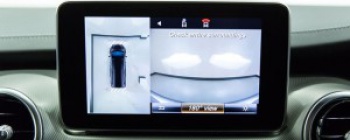
Already popular in car safety and driver assistance systems,
as well as in the HGV market, 360° cameras now look set to take off in the rapidly growing LCV market.
With a record four million vans now on our roads and increasing calls for operators to be fully accountable for fleets, especially in the burgeoning home delivery sector, onboard imaging could soon be seen as essential for both road safety and fleet monitoring purposes.
The onboard imaging market has advanced rapidly from the reversing sensors, through to their replacement with actual reversing cameras, with the introduction of dash-mounted screens along the way. And that’s just at the rear of the vehicle. Vehicle-mounted cameras have multiplied and are now found not just at the front, but also at the sides of cars to allow all-round, or 360° vision.
This type of technology is typically still optional on the majority of passenger cars, but the market is moving quickly and manufacturers don’t want to be left behind. And this shift extends to those producing commercial vehicles; to many people, it seems as though it is a case of when, not if, all-round camera technology will reach the commercial vehicle market.
Currently, reversing cameras are still only optional for many vans and LCVs, but in the medium term they could feasibly become standard (or even mandatory) kit. It stands to reason, then, that giving drivers complete, 360° vision of the vehicle is only a matter of time.
Those questioning the logic (and, now doubt – being budget-bound, the cost) behind the adoption of 360° camera systems might like to consider the benefits. First of all there’s the obvious safety advantage – multiple cameras on vehicles have helped to reduce/avoid accidents when parking or manoeuvring in passenger cars, and the same is expected in commercial vehicles. Their use protects not only the driver and his vehicle, but also other road users and pedestrians – the evolution of blind spot systems and evolution of reversing cameras have proven this fact. Given that vans and LCVs have more blind spots, 360° cameras are likely to be of even greater benefit to this class than passenger cars, especially as manufacturers work to improve night, glare and poor weather vision, which are currently the main criticisms of the systems.
Then there are the wider operational benefits that 360° cameras can bring. Reducing accidents means reduced risk of insurance claims – and therefore a possible cost-saving through lower premiums – and the vehicle downtime while repairs are made after an accident. When weighing up the pros and cons of picking camera technology from a vehicle’s options list, these considerations can be key and ultimately cameras can pay for themselves over the lifetime of the vehicle.
One manufacturer that has seen the progression in camera technology through to 360° systems is Mercedes-Benz. The system is now available on a number of models as an option, including the Vito van’s sister vehicle, the V-Class. According to the company, “the ‘Parking package’ with 360° camera, incorporating Active Parking Assist and a 360° camera, takes the strain off the driver when searching for a parking space, entering and leaving parking spaces, or manoeuvring.” There was no word as to when this technology might be seen on LCVs from the German manufacturer, but it wasn’t ruled out.
The forward march of 360° camera systems is more advanced in the HGV market than it is in the LCV market, with many manufacturers extolling the virtues of their systems at the CV Show earlier this year – proof that safety-related cameras are a growing requirement for some operators.
With so many delivery fleets now downsizing to the 3.5t market, it’s only a matter of time before such technology becomes more commonplace in the LCV market as well
SMMT: Transport news in brief
Images: TNB - Omni Vue & TNB - Mercedes Park Assit - 300x166

 Click here to open the navigation menu
Click here to open the navigation menu